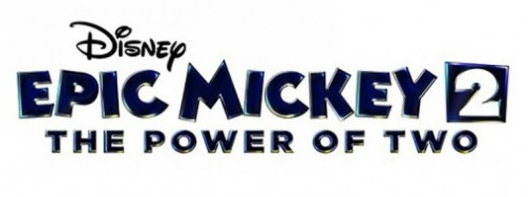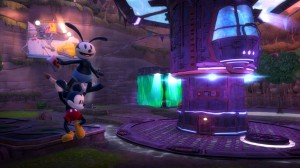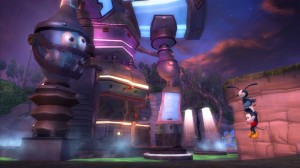[Review] Epic Mickey 2: The Power of Two (Wii Version)

I’ve said about the first Epic Mickey that it was a flawed, but ultimately deeply engaging exploration platforming experience. We don’t have enough of the genre these days, so when the inevitable sequel to the game– tag-lined “The Power of Two”– was announced, I felt quite a bit of reserved excitement. If Junction Point could manage to take the good of the first game, strike out the bad, and add just a few minor touches, we would have this generation’s Banjo Kazooie. After playing the game, I still stand by that concept.
The problem is that they didn’t do it.

Let’s get this out of the way: If you enjoyed the first Epic Mickey, you’ll find something to like here. The game’s high points are reminiscent of the first game in a lot of ways, and of those there are quite a few. It’s hard to say whether you’ll get $60 of enjoyment out of it (it’s about 11 hours long, barring sidequests/collectables), but you will chuckle to yourself and smile as the faithfully-recreated Disney magic swirls about the wonderful world of Wasteland.
So what’s the issue? Beyond the charm, the beauty, the music– beyond the atmosphere– the actual game is riddled with so many tiny flaws that it can be a challenge to enjoy all of that. I listed some of them off as I played the game over the past two days, so here’s an idea of what you’ll be dealing with:
– When a door opens or a secret is revealed, the camera doesn’t pan over to it and show you what you just unlocked. Characters will simply exclaim that you did something, and it’s up to you to try and find it.
– Like in the first game, the Wii’s IR cursor is low-FPS at best, outright jerky at worst. This makes it excruciatingly difficult to aim at times, and can cost you lives.
– In various levels the music would finish a loop and then just stop and remain silent. Sometimes it would start back up after a minute or two, but often times it would just remain silent until you died. Even the credit music just stopped twenty seconds or so before the credits finished.
– When something intense starts happening (like a large enemy crashes through the wall during a cutscene), the same bippity boppity level music continues to play, instead of something more urgent. It’s like listening to Skyward Sword’s ‘Faron Woods’ theme while fighting a boss.
– “Helpful” lines of dialogue are repeated every twenty-thirty seconds or so, ie “Work together to hit both switches!”. This is especially troublesome when it’s already painstakingly obvious what you’re supposed to do.
– If you talk to a character, their lines of dialogue don’t fade out as you get further away, and don’t stop even if a cutscene is triggered.
– The overall controls work, but don’t “feel” quite right. Things aren’t as tight and responsive as they should be, due in part to the fact that animations can be a little wonky. Best example of this I can give is when you latch onto a ledge. It doesn’t quite “feel” like you latched onto it– it feels like you triggered a pre-designed animation. Which you did, but it shouldn’t feel like that.
– Oswald’s AI (if you choose to play solo) is truly atrocious. You will die many, many times because he’s not where he should be, or he’s off doing his idle animation instead of helping you with something.
There were probably one or two more details like this that added up over time, and eventually turned certain areas that should have been fun and intriguing into frustrating, fetch-quest-feeling sections. Even more frustrating was the fact that if these simple technical issues didn’t exist, the game could easily be considered a truly fantastic platformer!

One thing that does work better than the first game is the good/evil system, which is just as subtle as it has been in the past, but whose effects are less so. It takes a page out of Fallout’s book in that your actions have small immediate consequences (“Hey! That was mean!), but major implications on how the final cutscene plays out. For example, I was trotting along in a place called “Bog Easy” when I stumbled across animatronic Donald Duck. He was going to miss a date with his girlfriend Daisy, and needed help making sure she didn’t get upset with him!
Now, I could have done the right thing and gotten more details, looked around for help, and then hopefully fixed a potentially-broken relationship. Instead I walked on by, far too transfixed with my overall mission at hand to spend any time working with a silly robo-duck! And it didn’t seem to matter all that much, until the final cutscene when you see Donald attempt to give Daisy flowers, a look of hope on his face…
She, of course, rejects them and their relationship will forever suffer because of it. A small decision on my part with big implications for a couple of robot avians!
My favorite case in which I did one of those jaw-dropping, gaspy things was when me and Aysha (podcast crew member who assisted me in playing the co-op of the game) were going around breaking all these funny looking magician hats with little blue bunny children in them. We assumed there would be no consequence– after all, they’re just silly hats!– but when we returned back to Mean Street (the hub world of the game), the owner of the ice cream parlor asked us if we would help find all of the silly blue bunny children and bring them back to their parents!
Uh oh. We had been not-so-gently slaughtering them throughout the various in-game worlds.
So we stopped. But not after Aysha unintentionally rolled a couple of them into an endless pit.

One of the main additions to this sequel was the inclusion of voice acting, and it’s something I was extremely hesitant about prior to playing. I’m happy to report, however, that 90% of it not only doesn’t detract from the experience, but it actually becomes nice to hear all of the characters speak. Even the musical bits were funny and well-sung, almost as if they were written by Disney’s team themselves…
Which brings me to the other main addition to this game over the first: The co-op. It is perhaps the most touted feature added in this sequel, and I’m sad to say that– on Wii at least– it’s not terribly successful. Framerate stutters are twice as common when playing with two people (hardly widespread, but they’re there), and the choice to split the screen vertically (rather than simply making two smaller boxes with the same aspect ratio) is something I shall never understand. It was hard to see what was going on at times, and it makes me hope that the Wii U version includes truly split-screen co-op between the TV and Gamepad. If it does, that in itself could warrant higher praises for the game.

Aesthetically at least the game is above almost anything else we’ve seen this generation, and it’s clear that the team knows how to recreate incredible environments that nigh flawlessly blend melancholy with magic. It is, in the best of ways, the feeling we used to get as children while going to theme parks or exploring new places, and that in an of itself will make this experience worth it for many people. Dare I say it has a bit of nostalgia, despite the fact that it’s a new game.
Still, gamers who care not for “feelings” and “magic” will perhaps find nothing redeeming about Epic Mickey 2. Unfortunate as it is, Junction Point dropped a ball that has the potential to become an extraordinary game series. I have my fingers crossed for a third entry.
Epic Mickey 2: The Power of Two is a wonderful, but deeply flawed game. Its issues are solely technical, but for the gamer who vests his or her interest in things like gameplay and high-production values, I’d recommend you look elsewhere.
Buy this game if…
You’re hankering for a clunky, but otherwise decent exploration platformer.
Don’t buy this game if…
You don’t care for magic, “feel”, or atmosphere.
This game is better than…
Rayman 3D, Glover
This game is worse than…
Epic Mickey, Banjo Kazooie